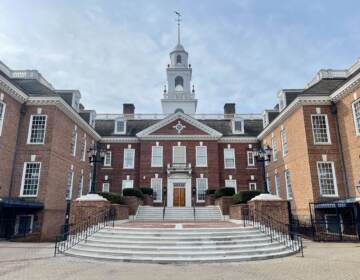After rocky year, Carney budget plan looks to rebuild Delaware’s reserves

Gov. Carney appears with Sec. of Finance Rick Geisenberger in a webcast of his annual budget presentation to state lawmakers. The graph on the left shows the highs and lows of state revenue in the past few years with the steadier blue line depicting a more even approach to spending that revenue.
2020 was a year of plenty for Delaware’s coffers.
A year ago, Gov. John Carney remarked on how easy it was to put together a budget in a good economy when the state is flush with revenue.
Less than two months later, the pandemic hit, and that rosy economic outlook ground to a halt amid lockdowns and COVID-19 fears.
Carney on Thursday introduced his latest budget proposal to fund the state starting July 1. Despite the challenge still posed by the coronavirus pandemic, Carney’s $4.7 billion operating budget and $894 million capital improvement plan are both the largest in state history. The plan does not include any increase in taxes or fees.
“This budget you will see reflects our priorities for a strong economy and jobs for Delawareans, for the best education for all of our children,” Carney said. Maintaining the health and wellness of state residents is also a top priority in the budget, he said. “It’s never been more important than the last 10 months, in the context of the COVID-19 pandemic.”
In addition to fully funding the state’s rainy day fund, which is required to be 5% of the state’s projected revenue, Carney’s plan would set aside another $68 million to bring the extra reserve account to $131 million. That reserve account could be used as a buffer that protects the state from another economic surprise.
“Fiscal [Year] ‘22 reinforces our commitment to rebuilding our economy — a significant objective this year, particularly with the effects of COVID-19 on so many businesses,” he said.
The plan would set aside yet another $30 million to fund unknown costs related to the pandemic in the coming year, including testing and contact tracing. Unlike the CARES Act funding the state received last year, the federal money coming to Delaware from the most recent coronavirus stimulus is much more restricted in how it can be spent.
New budget director Cerron Cade said the $30 million will supplement those incoming federal funds. “[That is] focused on any cost that may arise into Fiscal Year ‘22 related to the pandemic that cannot be covered by stimulus dollars,” he said. “This is going to be essential to ensuring that we covered all costs that may stem from this pandemic.”
The state got nearly $1 billion dollars from the CARES Act, which made a difference in terms of how bleak the state’s economy could have been.
“Back in March and April of last year, I had serious concerns about what the next several fiscal years were going to look like,” said State Sen. Brian Pettyjohn, a Republican from Georgetown. “The CARES Act money has helped tremendously and we’ve still got some good revenues coming in as well. It could have been a whole lot worse. We could be looking at significant cuts or real pressure for tax increases right now, but we’re not looking at either.”
The budget plan calls for $3.6 million to equip more police officers in the state with body cameras, and fund storage and analysis of the video those cameras capture. “We’ll be working together with our partners in DOJ as well as the Public Defender’s Office and other agencies to ensure that we figure out a way to incorporate this into the budget in an ongoing manner,” Cade said. The goal is to have all officers in the state wearing operational cameras by 2025.
Another $750,000 would fund ombudspersons in each county who can monitor and intervene in schools when there is unequal discipline or other unfair treatment of students. That position stems from the settlement of a lawsuit filed against the state by the NAACP and others that alleged the state provided deficient resources to low-income students, students with disabilities, and others.
The budget increases the state’s Opportunity Fund to provide for mental health services and supports for English learners and low-income students.
“We’re substantially increasing my highest priority, which is Opportunity Funding investments for our children from disadvantaged backgrounds and English learners in our schools who need additional support,” Carney said.
The budget includes an extra $10 million in help for those students, with the goal of spending $60 million annually for Opportunity Funding by 2025.
State employees would see a $500 pay raise in Carney’s plan. The $27 million funding for state employee pay would also include money to gradually raise all state workers to at least $15 per hour.
“It’s always been my view that those who work for the state of Delaware shouldn’t come to work, and work hard every day, and still live with wages under the poverty line. That’s been a goal of mine for some time,” Carney said.
He noted that the General Assembly is expected to consider legislation this year that would gradually increase the statewide minimum wage to $15 per hour and said the state should lead the way by making that move now.
State lawmakers on the Joint Finance Committee will spend the next six weeks going over Carney’s proposal. They have until June 30 to approve a budget for FY 2022, which starts July 1.

Get daily updates from WHYY News!
WHYY is your source for fact-based, in-depth journalism and information. As a nonprofit organization, we rely on financial support from readers like you. Please give today.






